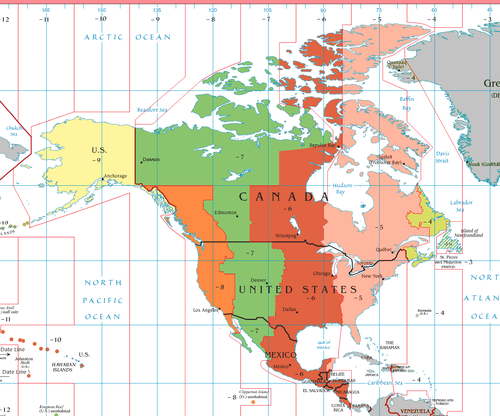| Mountain Time Zone | |
|---|---|
| Time zone | |
 Mountain Time Zone Shown offsets are Standard | |
| UTC offset | |
| MST | UTC−07:00 |
| MDT | UTC−06:00 |
| Current time | |
| 07:33, November 26, 2025MST[refresh] | |
| Observance ofDST | |
| DST is observed in some of this time zone. | |
TheMountain Time Zone ofNorth America keeps time by subtracting seven hours fromCoordinated Universal Time (UTC) when standard time (UTC−07:00) is in effect, and by subtracting six hours duringdaylight saving time (UTC−06:00).
In Canada, Mexico, and the United States, this time zone is generically calledMountain Time (MT). Specifically, it isMountain Standard Time (MST) when observing standard time, andMountain Daylight Time (MDT) when observing daylight saving time. The term refers to theRocky Mountains, which range fromBritish Columbia toNew Mexico. In Mexico, this time zone is known as thetiempo de la montaña orzona Pacífico ('Pacific Zone'). In the United States and Canada, the Mountain Time Zone is to the east of thePacific Time Zone and to the west of theCentral Time Zone.
In some areas, starting in 2007, the local time changes from MST to MDT at 2 am MST to 3 am MDT on the second Sunday in March and returns at 2 am MDT to 1 am MST on the first Sunday in November.
Most of Mexico, and most ofArizona in the United States, do not observe daylight saving time (DST), and during the spring, summer, and autumn months they are on the same time asPacific Daylight Time.[1] TheNavajo Nation is the only part of Arizona that observes DST. Its territory lies mostly within Arizona but extends intoUtah andNew Mexico (both observe DST statewide). Meanwhile, theHopi Reservation, despite being completely surrounded by the Navajo Nation, does not observe DST, and neither do some Arizona state offices located within the Navajo Nation.
The largest city in the Mountain Time Zone isPhoenix, Arizona; thePhoenix metropolitan area is the largest metropolitan area in the zone. The largest city that observes daylight saving time isJuárez, Chihuahua, Mexico.
The clock time in this zone is based on themean solar time at the105th meridian west of theGreenwich Observatory. In the United States, the exact specification for the location oftime zones and the dividing lines between zones is set forth in theCode of Federal Regulations at 49 CFR 71.[a]
One province and two territories are fully contained in the Mountain Time Zone:
On September 24, 2020, Yukon switched to the Mountain Standard Time year-round. Therefore, clocks in Yukon and Alberta are the same in the winter, and Alberta is one hour ahead in summer. Previously, the territory had used the Pacific Time Zone with daylight saving time: UTC−8 in winter and UTC−7 in summer.[5]
One province is split between the Mountain Time Zone and thePacific Time Zone:
One territory and one province are split between the Mountain Time Zone and theCentral Time Zone:
As of October 30, 2022, Mexico abandoneddaylight saving time, with certain exceptions. The followingstates have an offset equal to Mountain Standard Time:
The following states have an offset equal to Mountain Daylight Time:
Six states are fully contained in the Mountain Time Zone:
Three states are split between the Mountain Time Zone and thePacific Time Zone. The following locations observe Mountain Time:
Five states are split between the Mountain Time Zone and theCentral Time Zone. The following locations observe Mountain Time:
Alphabetical list of major cities located within the Mountain Time Zone. Cities inbold do not observe daylight saving time: